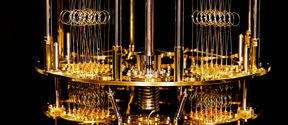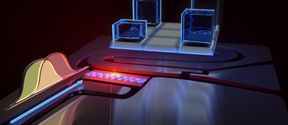Physicists embark on six-year hunt for dark matter particle
Researchers to probe the galactic halo in search of axions

Professor Sorin Paraoanu’s interest in science has grown in complexity over the years. As a ten-year-old he enjoyed soldering electronic components to build small analog devices. Now he is designing quantum sensors for a gigantic haloscope to be built deep underground in Europe to detect evidence of axions—hypothesized particles that could reveal the nature of the mysterious dark matter comprising large parts of our universe.
But for Paraoanu there is not so much difference between the two. He wants to build devices that have real technological perspective and scientific applications. In his pioneering work with quantum sensors this tends to go hand-in-hand with furthering our understanding of the universe.
After being appointed associate professor of experimental quantum physics at Aalto over the summer, Prof. Paraoanu of the Department of Applied Physics is set to do both.
Prof. Paraoanu’s unique and prolific scientific mindset has its origins in his childhood. As a child he would construct whatever devices he could from various electronic components after school.
“I built simple, analog electronics like transistor radios and amplifiers. I wanted to know how to make them work and to understand why they work. That motivated me to going to a math-oriented high school and later to studying physics,” Paraoanu says.
Paraoanu credits his thesis supervisor at the University of Bucharest with fostering his interest in quantum physics.
“I did my undergraduate thesis research under the direction of the late Academician Horia Scutaru in open quantum systems, which was an esoteric topic in the early 1990s. Now it has become a standard part of the curriculum in quantum physics.”
“I worked for a time in Bucharest as a physics researcher and then went on to earn my PhD in the United States working on the theory of ultra-cold atoms with Prof. Sir Anthony J. Leggett, a distinguished quantum scientist and winner of the 2003 Nobel Prize in Physics. After that I landed an experimental postdoc position in Prof. Jukka Pekola’s group in Jyväskylä the early 2000s.”
While there, Paraoanu secured a Marie Curie Fellowship and became an Academy of Finland Research Fellow soon after. In 2008 he decided to relocate to Otaniemi, to what was then the Helsinki University of Technology.
The Otaniemi campus houses the famed Low Temperature Laboratory, which is now part of the OtaNano national research infrastructure for nano-, micro and quantum technologies. Paraoanu quickly found an academic home among the cutting-edge equipment and experts of the Low Temperature Laboratory.
“In this field you need a lot of research infrastructure: cleanrooms, cryogenics, advanced electronics, and so on. You need expert technical knowledge around you. The LTL had all of that, so it was a perfect fit for me.”
After the LTL merged with the Department of Applied Physics, Paraoanu became a Senior Lecturer at Aalto. Over the years, he has seen experimental quantum physics evolve more and more into the direction of quantum information and applications.
“Condensed matter physics was the major mainstream topic when I started; only a handful of researchers were interested in quantum information. This has changed dramatically in the last couple of decades, since people realized that quantum information is not just fundamental research but can lead to actual, usable technology. And here we are now, talking about quantum computers, sensors, communication, and simulation.”

Throughout his career Paraoanu has often found himself drawn to overlooked or unintuitive ideas—even by quantum standards. Or just how intuitive does seeing quantum objects without looking at them, manipulating dark states in quantum circuits, or extracting colors from total darkness sound?
“My favorite work is digging up not so widely known ideas in quantum physics and seeing whether we can implement them in our experimental setups. Examples include interaction-free experiments, the dynamical Casimir effect, or superadiabatic processes. You don’t know beforehand whether they work, but if they do, you’ve discovered something outside what everybody else is chasing.”
There’s likely to be plenty more to discover as the core concepts of quantum physics still hide unforeseen consequences. For Paraoanu, that’s part of the appeal.
“I am still fascinated by the fundamental aspects of this theory. Despite over a hundred years of quantum physics we still cannot say that we fully understand it. Yet, we can use it in all of these devices: We can do the math and see in experiments that it indeed works.”
That mystery plays a role in his daily work. Paraoanu says that designing quantum experiments and building devices is nothing but incredibly skilled engineering, while every experiment carries with it the potential for unexpected results.
“There’s an element of surprise in experiments. Unexpected results can arise from the material you are working with or from a design issue, or they can be a fundamental phenomenon that you’ve just accidentally discovered.”
For now the new professor has his priorities sorted. Scientifically speaking, finding evidence of those axions and helming his KVANTTI research group at the Department will keep Paraoanu busy. Outside of scientific pursuits, he is excited about engaging with the community in his new role.
“The quantum community on campus and in Finland, i.e. academic institutions, companies and international partners, is already of very high quality. Maintaining this level takes dedicated work and people; and then going further, to the next level of excellence, will require a lot of inspiration and effort.”
While Paraoanu is happy with the number of fresh students taking up quantum technology studies at Aalto, he feels they could be engaged more comprehensively.
“We need to integrate practical lab work and research into the studies as early as possible. That would greatly benefit our students.”
He of all people would know the importance of getting to practical work early on. Despite his decades in the field and the increasing complexity of his work, Paraoanu says that the spirit of what he does is still the same as it was all those decades ago.
“What I do is not so far from what I learned as a ten-year-old. You have to think about each individual component in a device, understand what it’s doing, and learn how all the components work together. My devices just have many more parts now, and they live in a mathematical universe characterized by probabilities rather than certainties.”

Researchers to probe the galactic halo in search of axions

Our group is part of the effort in nanoelectronics in the Low Temperature Laboratory, Department of Applied Physics. The group is doing research in such fields as quantum information and quantum-level effects in superconducting devices, quantum coherent matter, and interaction of electromagnetic fields with nano-structured materials.

OtaNano is Finland's national research infrastructure for micro-, nano-, and quantum technologies


